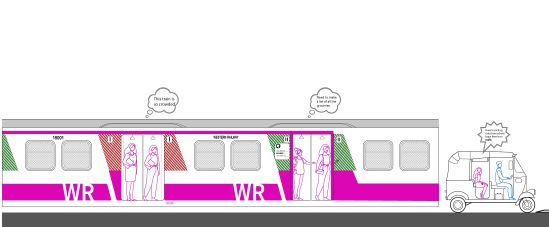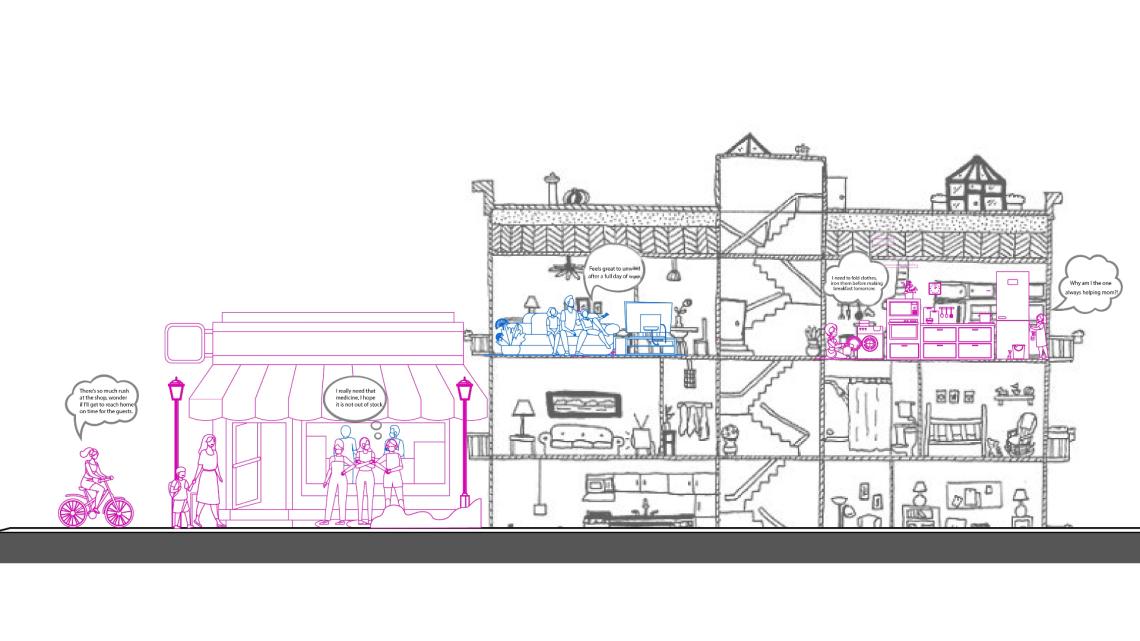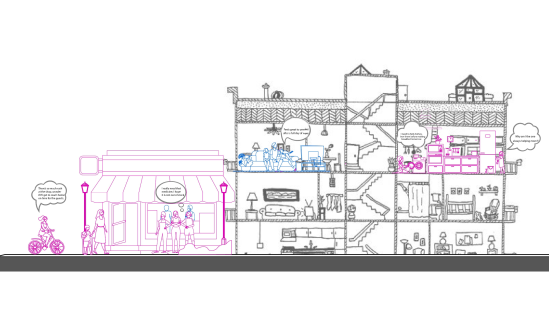In and around the commuting life in Mumbai

In and around the commuting life in Mumbai
As part of the C40 Cities Women4Climate Gendered Mobility in Climate Action research project, this blog post explores how gender roles and obligations are intertwined with travel. It also observes the trajectory of women’s roles segregated in each stage of their commute, find a few hidden meanings, and compares and contrasts with other family members - especially male members. What are some burdens women have to bear (like unpaid care work) while engaging in full-time work outside the home?
When we talk about the daily commute, we cannot ignore the many processes it intermingles with. The nature of a long and tedious commute often disrupts important tasks, and so, many of us prefer to juggle these while on the move. Think of your mother having to buy groceries on the way home after work, or your sibling delivering a parcel to your relative while going to their music class. The interviews act as empirical evidence to support common notions surrounding the gendered pattern of travelling. How does each stage of the commute - from train/metro, auto-rickshaw/scooter/intermediate transport, all the way to walking (and the overall pedestrian experience) have some gender obligations embedded in them? What else are women and gender minorities expected to take on, apart from the sheer experience of travelling?
An important step to reveal the gendered nature of spatial mobility is by segregating the micro-activities that one does while travelling. In his essay The Social Consequences of Hypermobility, John Adams talks about the concept of hypermobility, problematising the perils of increasing distances travelled by Britons in the 1990s (Adams, 1995). He further adds that this hypermobility would be essentially anti-public transit and would directly harm people opting for public transport (ibid). A similar phenomenon can be seen in the case of Mumbai, with commuters willing to travel farther and farther. A study by the CEPT University’s Centre for Excellence for Urban Transport estimates the average Mumbaikar travels 12.3 km to work in a single trip, every day (CET, 2018). However, this figure only considers the male commuter, and CUET’s data reveals that women in all the surveyed cities travel far less in trains and prefer “safer”, more pedestrian-friendly modes like walking (ibid). The average trip length has also increased significantly, with more women joining the formal workforce and opting to commute longer for work. This is where it is important to examine their hypermobilities through the intersection of gender. Lesley Murray in her essay Motherhood, Risk and Everyday Mobilities posits that hypermobility can be constructed and reinforced by motherhood, a role which is still highly gendered in the Indian context, whereas we can observe that care work or parenting is not gender-specific. Murray further supports this hypothesis by extending it to gendered and generational mobility - the experience of mobility by the parent (or mother) and their child is especially embedded with risk (Murray, 2008).
Along the same vein, one respondent, when asked about how other members of her family travelled, told us, “The others generally travel by train. My mother normally doesn't because she's having arthritis and problems walking. Usually, I buy things for her, she calls me when she needs something. My brother’s kids are very small to travel on their own. My brother goes to work in his company’s vehicle.” This revealed the multiple roles and the subtle deviations of routes women take to fulfil their family’s needs. This goes in conjunction with hypermobility - longer trip lengths can enable more tasks as errands to be added to women’s to-do lists.
Daily Commute - from the men’s perspective
While the sample size of our interviews lays emphasis on women and gender minorities and their narratives, we also focused on including a few male commuters in our cohort. We tried to interview men in lesser numbers but targeted diverse age ranges. Through their narratives, it was important to understand the contrasting nature of men’s travels, and that women’s travel patterns are almost complimentary to their male family members' experiences in some cases. This complimentary nature manifests in different forms - either through hypermobility coupled with added errands or through limited mobility, where the women have little to no opportunities to travel. One respondent says, “I stay in Vashi, and I get up for Namaaz early in the morning. Then I catch a train at 8 o'clock from Vashi and come here (CSMT). I have my own business here.” When asked about how his family members travel, he adds “Family members, they rarely travel. If they have some occasion then they travel, otherwise, they don't.”
One can also observe post-travel disparities between men's and women’s routines. As highlighted in the previous blog post, women tend to do the majority of the unpaid domestic work after a long commute. The same male respondent, when asked about his post-commute routine at night, adds, “Now when I go home, I'll do my Namaaz which I missed now (around 7:30 pm). Because I cannot pray here (in the station). I do Namaaz, have my dinner, watch TV News etc. and in the morning it's the same thing again.” One can clearly see the absence of domestic work and the inherent fatigue that comes with it.
Another male respondent in his late 50s laughs and sheepishly says “After reaching home, I am so very lazy. I tell my wife that I’ll rest for 15 minutes but it often extends to half an hour.” When asked whether he partakes in domestic work before starting his commute, he chimes in, “Every weekend I religiously tend to my garden. I have even received a certificate and appreciation from the BMC for this. I am very passionate about cleaning. Even at home, if I see anything dirty or out of place, I try to clean it.” It is interesting to note that while this respondent has received formal acknowledgement and appreciation for his work, the hours of unpaid domestic work possibly carried out by his female family members still remain under-acknowledged.
A Universal expectation
Another observation was the universality, regardless of their income level, of the expectations on women to do domestic work post-commute. One respondent, who is working at the Mumbai Stock Exchange says, “My husband and I start our commute to our offices in the car to Churchgate, and while coming back, since I have household work, I cannot wait for my husband to finish his work. I want to reach home as early as possible.
References
- Adams, J. (2001). The Social Consequences of Hypermobility. Prospect.
- Murray, L. (2008). Motherhood, Risk and Everyday Mobilities. Gendered Mobilities. Ashgate.
- John, P. (2018). Surtis commute the least, Mumbaikars most: Study. The Times of India.
https://timesofindia.indiatimes.com/city/ahmedabad/surtis-commute-the-least-mumbaikars-most-study/articleshow/65096432.cms
- Swamy, S. (2018). CEPT University’s Centre for Excellence for Urban Transport.






